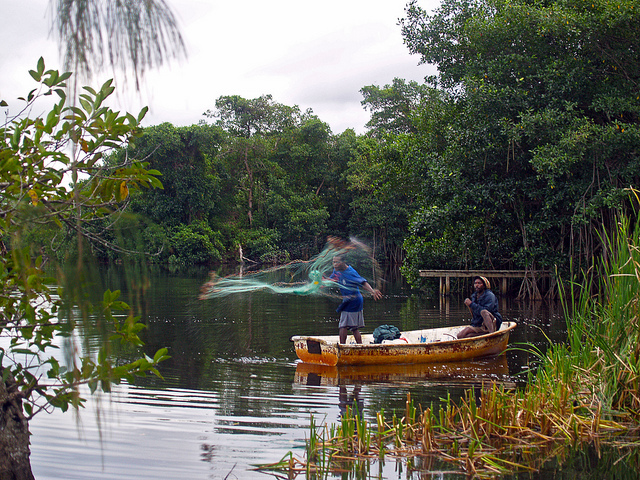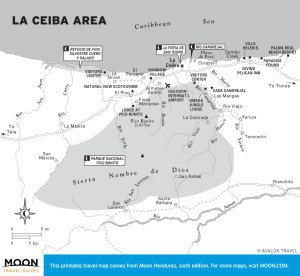
Local Garifuna fisherman casting their net into the river’s canals. Photo © Adalberto H. Vega, licensed Creative Commons Attribution.

La Ceiba Area
Formed by the estuaries of the Cuero, Salado, and San Juan Rivers, which flow off the flanks of the Cordillera Nombre de Dios to the south, the Cuero y Salado Wildlife Refuge comprises 13,225 hectares of wetlands and coastline filled with plant and animal life endangered elsewhere in Honduras. Jaguars, howler and white-faced monkeys, manatees (the reserve’s mascot), turtles, crocodiles, caimans, fishing eagles, hawks, and several species of parrots are among the 196 bird and 35 mammal species identified within the reserve’s boundaries.The swampy, mangrove-covered wetlands perform several important ecological functions. The dense walls of mangrove roots in the water act as a nursery for marine animals, such as shrimp and several fish species, who make their way out to the open ocean after they’ve had a chance to grow. The vegetation serves as a way station for many migratory birds and as a buffer zone protecting the surrounding area during ocean storms and floods coming down from the mountains.
Much of the north coast was formerly covered with similar wetlands, but most have since been converted to pasture or plantations—a process all too evident as Cuero y Salado is surrounded by encroaching cattle-grazing land. An estimated 40 percent of the reserve’s wetlands have been drained since 1987, when the land was donated by Standard Fruit to become a reserve. Recent efforts to transition cattle-ranchers into the forestry industry (primarily planting palm and mahogany) seem to be working. However, chemicals leaking in from nearby pineapple and African palm plantations also threaten the wetlands.
By far the best way to appreciate Cuero y Salado is on a guided boat tour of the reserve, either with another tour or by just showing up at the visitors center, although finding a boat can be difficult at times, so calling ahead is worthwhile. The trips, taking about two hours, tour through different waterways, with frequent stops to listen and watch for monkeys, birds, crocodiles, and other wetland denizens. Early-morning tours are the best for wildlife-watching. The guides are people from the community who have received training and are very knowledgeable about the ecosystems and wildlife in the area. They can usually help visitors get a good look at a troop of howler monkeys or some of the more colorful bird species in the reserve. Don’t count on seeing one of the reserve’s famed manatees—not only are they shy, they tend to hang out at the far side of the reserve. Be sure to bring some repellent or wear long sleeves—the mosquitoes aren’t too bad on the beach or at the encampment but can be fierce in the swamp. There is a wide-open, deserted stretch of Caribbean beach that can be reached by foot from the visitors center (although it’s a longish walk), perfect for a cooling-off swim after your boat tour.
For tourists, the interior section of the reserve is accessible by boat only, but don’t be surprised to see a couple of locals standing on the shore farther in the swamps, fishing for their dinner. They know all the paths to get into the reserve and don’t mind getting munched by mosquitoes to catch a free meal for their families.
The park is open 6 a.m.–6 p.m. daily. A US$10 (US$5 for students with credential) entrance fee is charged above the price of the boat ride. Visitors who are not with a group can then choose between a canoe (for one or two passengers, US$6, plus US$10.50 for a guide) or a larger boat (which can accommodate up to eight passengers) with a guide (US$17 for 1–2 passengers, US$8 each additional passenger, and another US$8 for the guide). Canoeing is ideal, as it’s easier to spot animals when you don’t have a buzzing motor to scare them off, and hiring a guide is money well spent, as their eyes are trained to spot every sloth, crocodile, and howler monkey hiding in the foliage. To reserve your boat, call the offices of the Fundación Cuero y Salado (tel. 504/2443-0329) in La Ceiba.
Since the early morning and late afternoon are the best times for wildlife-viewing, some visitors may wish to spend the night. The reserve has a rustic five-bedroom cabin; beds are US$8 per person, although the cabin was being remodeled at the time of writing—contact the Fundación to check on availability. Otherwise, visitors can pitch their own tent for US$4, or rent a tent and sleeping bags from the visitors center for a few more bucks. Locals will cook up a meal for unprepared visitors, but it’s best to come with food. The beach is a great spot for a bonfire cookout (but bring mosquito repellent). Accommodations may be simple, but those who have stayed the night rave about the wildlife out for spotting in the early morning.
Cuero y Salado is 33 kilometers east of La Ceiba. To get there, take a bus or car from La Ceiba past the airport on the road to Tela, and turn right into pineapple fields shortly after crossing the Río Bonito bridge. This road continues to the village of La Unión, but get off where the railroad tracks cross the road. From here, the Ferrocarril Nacional runs a small railcar for US$10 for a solo ride round-trip, or US$5 per person with two or more passengers. There are seven departures a day, at 7 a.m., 8:10 a.m., 9:20 a.m., 10:30 a.m., 11:40 a.m., 12:50 p.m., and 2 p.m. The train returns to La Unión immediately after arriving in the park, with the last return at 2:30 p.m. Prices for returning the following day are 50 percent more. An armed military guide now rides the rail along with guests, due to a holdup (where tourists had their cameras stolen) in 2010. For those saving their pennies, it’s a hot two-hour walk along the rails to reach the visitors center. Buses from La Ceiba to La Unión leave from the main terminal every hour between 6:30 a.m. and 6 p.m. When returning, keep in mind that the last bus bound for La Ceiba passes at 4 p.m.
It’s recommended that independent visitors make reservations with Fundación Cuero y Salado (FUCSA, tel. 504/2443-0329) in La Ceiba for boat tours, as groups often visit the reserve. Staff can also put you in touch with the ferrocarril to reserve your train ride. You can also stop in to the Unidad Turística Municipal on 8 Calle half a block from La Ceiba’s central square for more information.
Excerpted from the Sixth Edition of Moon Honduras.